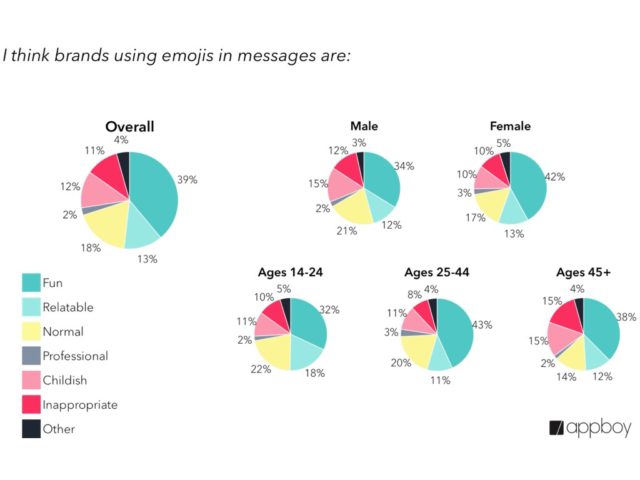Those little faces and icons—emoji, as they call ’em—are everywhere. From text messaging to emails to Kim Kardashian’s cleavage through Kimoji, and now, marketing. Brands are turning to the age-old tradition of communication through symbols to reach their customers on an emotional level.
Recently, Pepsi created an entire campaign around the idea, and L’Oreal created their own keyboard for beauty enthusiasts. Volvo used a combination of emoji and photos to tease its latest model on Snapchat, using a casual tone to build hype around the brand. Disney Interactive, meanwhile, has integrated the expressive power of character-themed emoji into a new game.
While marketers may not hesitate to insert a smiley face into their inter-office chat or text message to mom, the idea of using an emoji to communicate with customers may seem inappropriate. To find out how consumers respond to those little faces, research firm Appboy surveyed over 500 individuals about their perception.
In general, people respond well to emoji-based marketing. The poll found that overall, 52 percent find their use to be fun or relatable. However, it’s important to note the remaining 47 percent of those surveyed range from a resounding “meh” to downright disgusted. As always, the use of a popular marketing tactic comes down to knowing the target audience. For example, those surveyed over 45 years of age were the most opposed to emoji messaging in ads, while those between the ages of 25 and 44 find them to be the most fun.

Appboy’s study found that active marketing campaigns containing emoji have increased by 557 percent year-over-year. While brands are jumping onto the smiley-face hype as if it were a Botox clinic in Beverly Hills, the question, as always, will be return on investment.
Conversion rates associated with emoji messaging campaigns have also increased 135 percent during that time, according to the report, “though other factors beyond the use of emojis could potentially be impacting the number of conversions produced by individual campaigns.” While early attempts at the marketing tactic were more of a shotgun effect, brands are paying more attention to who these messages are being sent to. “[The conversion rate] suggests that brands are increasingly taking advantage of segmentation and message targeting to deliver messages with emojis to customers who are likely to be interested in receiving them,” Todd Grennan, senior content producer at Appboy, notes in the study.
So, why do customers respond to emoji? They’re casual, universally understood and easy to use in everyday conversation. On a scientific level, the human brain has adapted to recognize type-based emoticons much in the same way as a real-life facial expression.
According to a recent study published in the journal Social Neuroscience, looking at faces crafted from colons and parentheses can trigger the same facial recognition response in the brain that takes place when we read the subtle expressions of another human.
Could picture emoji be the next step in facial recognition? “There is no innate neural response to emoticons that babies are born with. Before 1982 there would be no reason that ‘:-)’ would activate face sensitive areas of the cortex but now it does because we’ve learnt that this represents a face,” researcher Owen Churches told Australia’s ABC. “This is an entirely culturally-created neural response. It’s really quite amazing.”
